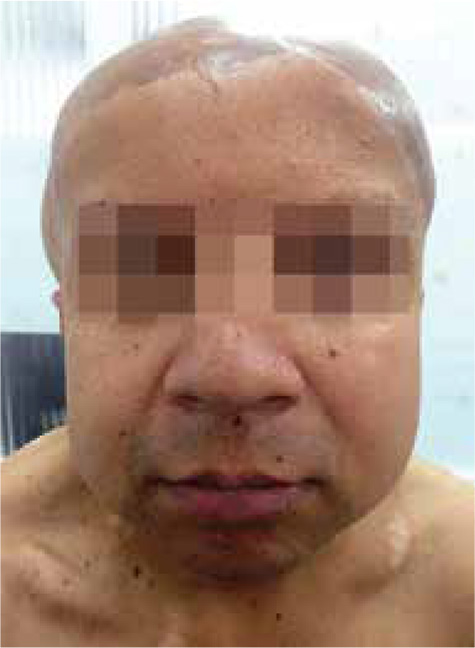Gorlin syndrome with metastatic basocelular carcinoma in treatment with vismodegib
Keywords:
Gorlin syndrome, molecular targeted therapy, basal cell carcinoma, lung metastasis.Abstract
The Gorlin-Goltz syndrome or basal cell nevoid carcinoma syndrome is a rare autosomal dominant disorder characterized by odontogenic keratocysts of the jaw, plantar or palmar pits and multiple basal cell carcinomas (BCC). There can be also other malignancies such as medulloblastoma, meningioma or rhabdomyosarcoma. This disorder is explained by loss of the inhibition normally exerted by the membrane protein PTCH (Drosophila patched gene Human Analogue) over SMO (Smoothened) which promotes cell proliferation and invasion. Identification of this oncogen addicted pathway has generated targeted therapies such as Vismodegib, a SMO inhibitor. The BCC is an indolent disease, but in Gorlin syndrome, it is aggressive and has risk of local recurrence and metastases, with minimal treatment options. A patient with Gorlin syndrome and pulmonary metastatic BCC is described, who after 6 cycles of treatment with Vismodegib had partial response with minimal toxicity.
Author Biographies
Diego Mauricio González
Médico Internista en entrenamiento en Oncología Clínica, Instituto Nacional de Cancerología, Bogotá D.C., Colombia. Universidad El Bosque, Bogotá D.C., Colombia
Juan Carlos Velásquez
Médico Internista en entrenamiento en Oncología Clínica, Instituto Nacional de Cancerología, Bogotá D.C., Colombia. Universidad El Bosque, Bogotá D.C., Colombia
Luisa Alejandra Galvis
Médico Internista en entrenamiento en Oncología Clínica, Instituto Nacional de Cancerología, Bogotá D.C., Colombia. Universidad El Bosque, Bogotá D.C., Colombia
Leonardo Pulido
Médico Especialista en Dermatología , Instituto Nacional de Cancerología, Bogotá D.C., Colombia. Especialista.
References
2. Satinoff MI, Wells C. Multiple basal cell naevus syndrome in ancient Egypt. Med Hist. 1969;13:294-7.
3. Kimonis VE, Goldstein AM, Patakia B, Yang ML, Kase R, DiGiovanna JJ, et al. Clinical manifestation in 105 persons with nevoid basocell carcinoma syndrome. Am J Med Genet. 1997;69:299-308.
4. Winkler PA, Guyuron B. Multiple metastases from basal cell naevus syndrome. Br J Plast Surg. 1987;40:528.
5. Weinstock MA, Bogaars HA, Ashley M, Litle V, Bilodeau E, Kimmel S. Nonmelanoma skin cancer mortality. A population-based study. Arch Dermatol. 1991;127:1194.
6. Ting PT, Kasper R, Arlette JP. Metastatic basal cell carcinoma: Report of two cases and literature review. J Cutan Med Surg. 2005;9:10.
7. High A, Zedan W. Basal cell nevus syndrome. Curr Opin Oncol. 2005;17:160-6.
8. Evans DG, Ladusans EJ, Rimmer S, Burnell LD, Thakker N, Farndon PA. Complications of the naevoid basal cell carcinoma syndrome: Results of a population based study. J Med Genet 1993;30:460-4.
9. Muller EA, Aradhya S, Atkin JF, Carmany EP, Elliott AM, Chudley AE, et al. Microdeletion 9q22.3 syndrome includes metopic craniosynostosis, hydrocephalus, macrosomia and developmental delay. Am J Med Genet A. 2012;158A:391-9.
10. Shimojima K, Adachi M, Tanaka M, Tanaka Y, Kurosawa K, Yamamoto T. Clinical features of microdeletion 9q22.3 (pat). Clin Genet. 2009;75:384-93.
11. Redon R, Baujat G, Sanlaville D, Le Merrer M, Vekemans M, Munnich A, et al. Interstitial 9q22. 3 microdeletion: Clinical and molecular characterisation of a newly recognised overgrowth syndrome. Eur J Med Genet. 2006;14:759-67.
12. Hahn H, Wicking C, Zaphiropoulos PG, Gailani MR, Shanley S, Chidambaram A, et al. Mutations of the human homolog of Drosophila patched in the nevoid basal cell carcinoma syndrome. Cell. 1996;85:841-51.
13. Levanat S, Gorlin RJ, Fallet S, Johnson DR, Fantasia JE, Bale AE. A two-hit model for developmental defects in Gorlin syndrome. Nat Genet. 1996;12:85-7.
14. Gailani M, Stahle-Backdahl M, Leffell D, Glynn M, Zaphiropoulos P, Pressman C, et al. The role of the human homologue of Drosophila patched in sporadic basal cell carcinomas. Nat Genet. 1996;14:78-81.
15. National Comprehensive Cancer Network. Basal Cell Skin Cancer (Version 1.2016). Fecha de consulta: 28 de octubre de 2015. Disponible en: http://www.nccn.org/professionals/physician_gls/pdf/nmsc.pdf.
16. Featherstone T, Taylor AM, Harnden DG. Studies on the radiosensitivity of cells from patients with basal cell naevus syndrome. Am J Hum Genet. 1983;35:58-66.
17. Sekulic A, Migden MR, Oro AE, Dirix L, Lewis KD, Hainsworth JD, et al. Efficacy and safety of vismodegib in advanced basal-cell carcinoma. N Engl J Med. 2012;366:2171-9.
18. Tang JY, Mackay-Wiggan JM, Aszterbaum M, Yauch RL, Lindgren J, Chang K, et al. Inhibiting the hedgehog pathway in patients with the basal-cell nevus syndrome. N Engl J Med. 2012;366:2180-8.
19. Orouji A, Goerdt S, Utikal J, Leverkus M. Multiple highly and moderately differentiated squamous cell carcinomas of the skin during vismodegib treatment of inoperable basal cell carcinoma. Br J Dermatol. 2014;171:431-3.
How to Cite
Downloads

Downloads
Published
How to Cite
Issue
Section
| Article metrics | |
|---|---|
| Abstract views | |
| Galley vies | |
| PDF Views | |
| HTML views | |
| Other views | |






